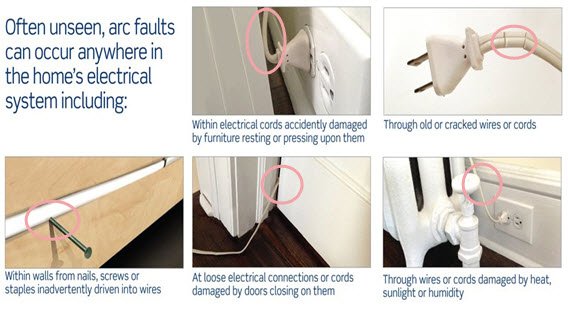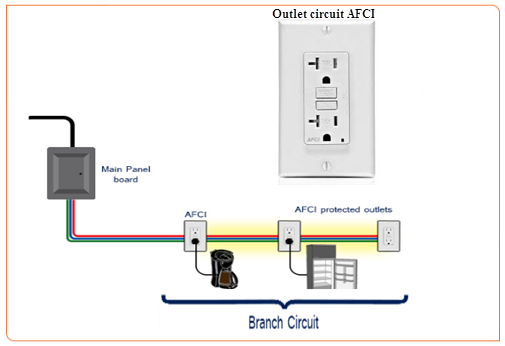Photo of the day: Arc-Fault Circuit Interrupters (AFCI)
8 min readHome fires are more deadly and costly than ever. While the number of total fires and fire injuries is decreasing, property damage and fire deaths are on the rise. Each year arc-faults, caused by worn and inadequate wiring, overburdened circuits, outdated technology, and aging electrical systems, start more than 35,000 home fires causing over 1,130 injuries, 500 deaths, and $1.4 billion in property damage.
An arc fault circuit interrupter (AFCI) is a circuit protection device designed to protect against fires caused by arcing faults in electrical wiring. An arc fault circuit interrupter is defined as “a device proposed to provide protection from the effects of arc faults by recognizing arcs and by functioning to de-energize the circuit when an arc fault is detected.”
The photo of today will outline the meaning of AFCI and the common causes of Arc-Faults in addition to the different types of Arc-Fault Protection

What is an arc fault?
An arc fault is a dangerous electrical problem caused by damaged, overheated, or stressed electrical wiring or devices.
Arc faults can occur when older wires become frayed or cracked, when a nail or screw damages a wire behind a wall, or when outlets or circuits are overburdened.
Common Causes of Arc-Faults:
- Damaged electrical wiring
- Wiring damaged by screws or nails
- Wiring damaged by doors
- Damaged electrical insulation
- Overheated cords under carpets or rugs
- Damaged or loose connections
- Cords and plugs damaged by furniture
Arc-Fault Protection is Required in:
- Bedrooms
- Closets
- Kitchens
- Laundry areas
- Living rooms
- Family rooms
- Rec rooms
- Parlors, libraries, or dens
What are arc fault circuit interrupters, or AFCIs?
Arc fault circuit interrupters, or AFCIs, are devices that provide a higher level of protection by detecting hazardous arcing conditions and shutting down the electricity before a fire can start
Theoretically, an arc is defined as a Continuous illumination discharge of electricity across an insulating medium, usually supplemented by the partial volatilization of the electrodes. An AFCIs are designed into conventional circuit breakers combining traditional overload and short-circuit protection with arc fault protection.
The AFCI circuit interrupters provide protection for branch circuit wiring and limited protection for power cords and extension cords. The AFCI circuit breakers have a test button and look similar to the GFCI circuit breakers shown in the below figure. Generally, AFCIs require monthly testing to notify the user that the AFCI is functioning properly.
There are several probable reasons an arc fault may occur, as given below.
- Improper installation or stabbing of a wire with a screw, nail during installation or maintenance of the electrical system.
- Damaging of extension or appliance cords by vacuum cleaners, door furniture or an appliance has been positioned on the cord.
- The advanced age of extension or appliance cords, or even wiring in the walls, which can over time experience worn or cracked insulation.
- Loose connections in outlets, switches, and light fixtures.
- Appliance cords damaged by heat, kinking, impact or over-extension, spillage of liquid.

Parallel and Series ARC Faults
Any of the above circumstances, which we discussed above can result in a parallel or series arc. The parallel arc fault arises, when the current flows through damaged insulation from one conductor to another conductor, producing a short circuit that is too weak to be detected by the circuit breaker.
A Series arc fault arises, when a single wire is damaged and cannot tolerate the current, causing the current to arc from the conductor into the insulation. This leakage current can burn and eventually burn the insulation.

How Arc-Fault Circuit Interrupters Work
The AFCI circuitry always monitors the current flow through the AFCI. The Arc-Fault Circuit Interrupters use detection circuitry to discriminate between normal and unwanted arcing conditions. Once an unwanted arcing condition is detected, the control circuitry in the AFCI trips the internal contacts, thus de-energizing the circuit and reducing the potential for a fire to occur.
The arcs produce a current signature or waveform. The faulty arc can produce a non-periodic waveform. Various methods for the detection of fault arcs include looking at certain frequencies, discontinuities, and variations in the current waveform. For detection, both the magnitude and time period of a particular half cycle are required.
An Arc-Fault Circuit Interrupter should not trip during regular current conditions. The below illustration is a block diagram of a single-pole AFCI circuit breaker.

The AFCI electronics can function independently from the conventional circuit breaker. The conventional circuit breaker has thermal and instantaneous sensing functionality. Using a load current sensor, the AFCI electronics detect the current flow from the load terminals.
The load current sensor can be either a resistive or a magnetic sensor. The load current sensor’s output is fed into an arc signature filter that passes frequency components of arcing waveforms while rejecting other power line frequencies.
The arc signature filter output is amplified and fed into a logic circuit that determines that any unsafe condition exists in the current flow. As discussed before, both amplitude and time period are used to detect the unwanted arcing condition.
If the logic determines that the load must be deactivated, a signal is fed to a TRIAC used to energize a solenoid that opens the circuit breaker contacts. A test circuit is provided to ensure that the arc fault detection circuit is functioning properly or not.
A test button functionality is used to generate a signal that is similar to an arcing output waveform of the load current sensor. The test button will deactivate the circuit if the device is functioning properly.
Types of Arc-Fault Protection:
- A listed combination-type AFCI circuit breaker
- A listed outlet branch-circuit-type AFCI receptacle
- A listed outlet branch-circuit-type AFCI receptacle in combination with a listed branch-circuit overcurrent device
Types of Arc Fault Circuit Interrupters
AFCI breakers and receptacles protect all downstream wiring and appliances from arc faults. Receptacles should be installed at the first outlet box of a circuit.
Here different types of AFCIs are available depending upon their viable applications.
Outlet Circuit AFCI
It is intended to provide protection to branch circuit wiring, power supply cords, and cord sets connected to it against the unwanted effects of arcing.

Branch/ Feeder AFCI
These are installed at the origin of the feeder or branch circuit. It is intended to provide protection to the feeder or branch wiring.
Combination AFCI
The combination Arc-Fault Circuit Interrupter combines both the features of the OC and B/F. It is intended to provide protection to protect the appliance cords, extension cords, branch circuits, and feeder wiring.
A typical combination Arc-Fault Circuit Interrupter provides
- Series arc fault protection
- Parallel arc protection
- Ground protection
- Short circuit protection
- Overload protection
Portable AFCI
This is a plug-in device that is typically connected to the receptacle outlet and has one or more protected outlet. It is intended to provide protection to the connected extension cords and appliances.

Cord AFCI
The cord AFCI is also a plug-in device that is connected to the receptacle outlet and is often used to protect the connected power cord.

Download the infographic
Arc-Fault Circuit Interrupters (AFCI)
More Photos
- Photo of the day: 10 Essential Safety Tips for Driving in Hot Weather Conditions
- Photo of the day: best workplace safety tips
- Photo of the day: The Importance of Stop Work Authority in Maintaining Workplace Safety
- Photo of the day: Tomorrow’s Reward for Working Safely Today: Cultivating a Culture of Safety
- Photo of the day: Preventing slips and trips at work
- Photo of the day: Learn the DRSABCD action Plan
- Working with Electricity Electrical Accidents Guide for Electrical Workers
- Photo of the day: Hearing Protection Device Selection
- Photo of the day: If An Earthquake Shakes You-Infographic free
- Fire Safety Posters Free Download
- Photo of the day: First Aid for Electrical Burns-Infographic free
- Infographic: First Aid for Cuts and Scrapes free download
- Photo of The day: Work Safe with Lasers-Laser Safety free
- Photo of the day: Working Safely with chemicals and chemical Management
- Photo of the day: Safe work practices when using MEWPs ( updated)
- Photo of the day: Preventing Common Kitchen Hazards
- Photo of the day: Safe handling of Gas Cylinders and lecture bottles
- Photo of the day: Forklift Stability Triangle
- Photo of the day: Defective Tools Safe Work Practice
- Photo of the day: Lift With Your Legs Not With Your Back
- Photo of the day: First Aid for burns
- Photo of the day: The 7 Principles of HACCP
- Photo of the day: Working Safely with Suspended Loads
- Photo of the day: Heat Stroke First Aid and safety posters
- Photo of the day: Near-Miss Reporting and Posters
- Photo of the day: Ergonomic chair and office chair safety tips
- Photo of the day: Whole Body Vibration
- Photo of the day: Substation Safety Equipment
- Photo of the day: Bypassing Safety Controls Rules
- Photo of the day: Lightning Safety Tips
- Photo of the day: Overhead Power lines Clearance
- Photo of the day: Floor Marking
- Photo of the day: Types of Foot Protection
- Photo of the day: Types of Hand Protection
- Photo of the day: Lockout and Tagout Safety
- Photo of the day: Fall Protection Plans
- Photo of the day: Flood Safety Tips
- Photo of the day: Read All Labels Work safe
- Photo of the day: Run Project safely with Crane Hand Signals
- Photo of the day: Flagman and Traffic control
- Photo of the day: Managing Risks of Exposure to Solvents in the workplace
- Photo of the day: Scissor Lift Safety
- Photo of the day: HSE Bulletin Board
- Photo of the day: Arc-Fault Circuit Interrupters (AFCI)
- Photo of the day: Safe use of ladders and step ladders
- Photo of the day: Concrete Truck Driver Hand Signals
- Photo of the day: Extension Cord Safety Tips
- Photo of the day: Protect your Head
- Photo of the day: choosing the right Anchorage
- Photo of the day: Work-Related Asthma
- Photo of the day: Top FIVE Heavy Equipment Construction Site Safety Tips
- Photo of the day: sun safety in the workplace
- Photo of the day: Cannabis and Impairment in the Workplace
- Photo of the day: Position for safety and comfort-Safety Tips
- Photo of the day: Generator Safety
- Photo of the day: Controlling COVID-19 in the Workplace-Physical Barriers
- Photo of the day: Manual Material handling
- Photo of the day: Personal Protective Equipment last resort
- Photo of the day: WHMIS 2015 – Pictograms
- Photo of the day: Indoor Air Quality
- Photo of the day: Noise in the affected workplace
- Photo of the day: Fatigue at Work
- Photo of the day: Don’t be Driven to Distraction
- Photo of the day: working in heat and Humidex Rating
- How to use Plate Clamps Safely: Safety Moment#34
- Photo of the day: Sitting at work
- Photo of the day: 5 ways to reduce the risk of Slipping and Tripping
- Photo of the day: Preventing the spread of contagious illness
- Photo of the day: Incident Investigations
- Photo of the day: 10 Scaffold Safety Essentials
- Photo of the day: Effective Health and Safety Committees
- Photo of the day: New worker Orientation & Safety Orientation checklist
- Photo of the day: Workplace Inspection
- Photo of the day: musculoskeletal disorders
- Photo of the day: Emergency preparedness in the workplace
- Photo of the day: Mental health in the workplace
- Photo of the day: Trenching Safety Tips That Can Save a Life
- Photo of the day: Dangerous Goods Classes



